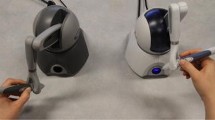Abstract
Current computer-aided assembly systems provide engineers with a variety of spatial snapping and alignment techniques for interactively defining the positions and attachments of components. With the advent of haptics and its integration into virtual assembly systems, users now have the potential advantage of tactile information. This paper reports research that aims to quantify how the provision of haptic feedback in an assembly system can affect user performance. To investigate human–computer interaction processes in assembly modeling, performance of a peg-in-hole manipulation was studied to determine the extent to which haptics and stereovision may impact on task completion time. The results support two important conclusions: first, it is apparent that small (i.e. visually insignificant) assembly features (e.g. chamfers) affect the overall task completion at times only when haptic feedback is provided; and second, that the difference is approximately similar to the values reported for equivalent real world peg-in-hole assembly tasks.












Similar content being viewed by others
References
Amirabdollahian F, Gomes GT, Johnson GR (2005) The peg-in-hole: a VR-based haptic assessment for quantifying upper limb performance and skills. In: Proceedings of the 9th IEEE international conference on rehabilitation robotics, pp 422–425
Bashir AB, Bicker R, Taylor PM (2004) An investigation into different visual/tactual feedback modes for a virtual object manipulation task. In: Proceedings of the ACM SIGGRAPH international conference on virtual reality continuum and its applications in industry, pp 359–362
Boothroyd G, Dewhurst P, Knight W (2002) Product design for manufacture and assembly, 2nd edn. ISBN 0-8247-0584-X
Brooke J (1996) SUS—a quick and dirty usability scale. Redhatch Consulting Ltd., 12 Beaconsfield Way, Earley, Reading RG62UX, UK
Caselli S, Magnanini C, Zanichelli F, Caraffi E (1996) Efficient exploration and recognition of convex objects based on haptic perception. Proc IEEE Int Conf Robot Autom 4:3508–3513
Fitts PM (1954) The information capacity of human motor systems in controlling the amplitude of a movement. J Exp Psychol 47:381–391
Gerovichev O, Marayong P, Okamura AM (2002) The effect of visual and haptic feedback on manual and teleoperated needle insertion. In: Proceedings of the 5th international conference on medical image computing and computer-assisted intervention, Part I, vol 2488, pp 147–154
Gosset, William Sealy 1876-1937 (1970). In: Pearson ES, Kendall MG (eds) Studies in the history of statistics and probability, pp 355–404
Gupta R, Whitney D, Zeltzer D (1997) Prototyping and design for assembly analysis using multimodal virtual environments. CAD 29(8):585–597
Haeusler J (1981) Design for assembly—state-of-the-art. In: Proceedings of the 2nd international conference on assembly automation, Brighton, pp 109–128. ISBN 0903608162
Hara K, Yokogawa R, Kai Y (1997) Evaluation of task-performance of a manipulator for a peg-in-hole task. In: Proceedings of IEEE international conference on robotics and automation, Albuquerque, New Mexico, pp 600–605
Ho C, Boothroyd G (1979) Design of chamfers for ease of assembly. In: Proceedings of the 7th manuf eng trans North AME metalwork res conf, pp 345–354
Johan T, Jan W (2005) Tactile sensing in intelligent robotic manipulation—a review. Ind Robot 32/1:64–70
Kim IW, Lim DJ, Kim KI (1999) Active peg-in-hole of chamferless parts using force/moment sensor. In: Proceedings of the IEEE/RSJ international conference on intelligent robots and systems, pp 948–953
Lim T, Dewar R, Calis M, Ritchie JM, Corney JR, Desmulliez M (2006) A structural assessment of haptic-based assembly processes. In: 1st international virtual manufacturing workshop (VirMan’06), 26 March 2006, Virginia, USA, vol 29
Massie T, Salisbury K (1994) The PHANTom haptic interface: a device for probing virtual objects. ASME Winter Annual Meeting, DSC, vol 55-1, pp 295–300
Massimo MJ, Sheridan TB (1993) Sensory substitution for force feedback in teleoperation. Presence Teleoper Virtual Environ 2(4):344–352
Okamura AM, Turner ML, Cutkosky MR (1997) Haptic exploration of objects with rolling and sliding. IEEE international conference on robotics and automation, Albuquerque, New Mexico, pp 2485–2490
Rosenberg, LB (1993) Virtual fixtures: perceptual tools for telerobotic manipulation. In: IEEE virtual reality annual international symposium, pp 76–82
Rosenberg L (1994) Virtual fixtures. PhD Dissertation, Stanford University
Sener B, Wormald P, Campbell I (2002) Evaluating a haptic modelling system with industrial designers. In: Proceedings of the EuroHaptics international conference, Edinburgh, Scotland, pp 165–170
Sheridan TB (1992) Telerobotics, automation and human supervisory control. MIT Press, Cambridge
Unger BJ, Nicoladis A, Berkelman PJ, Thompson A, Klatzky RL, Hollis RL (2001) Comparison of 3-D haptic peg-in-hole tasks in real and virtual environments. In: Proceedings of the IEEE/RSJ international conference on intelligent robots and systems, pp 1751–1756
Yoshikawa T, Kawai M, Yoshimoto K (2003) Toward observation of human assembly skill using virtual task space. Experimental Robotics VIII, STAR 5, pp 540–549
Author information
Authors and Affiliations
Corresponding author
Rights and permissions
About this article
Cite this article
Lim, T., Ritchie, J.M., Dewar, R.G. et al. Factors affecting user performance in haptic assembly. Virtual Reality 11, 241–252 (2007). https://doi.org/10.1007/s10055-007-0072-8
Received:
Accepted:
Published:
Issue Date:
DOI: https://doi.org/10.1007/s10055-007-0072-8




